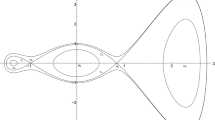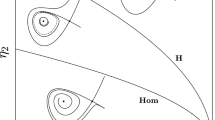Abstract
By combining the generalized Padé approximation method and the well-known Lindstedt–Poincaré method, a novel technique, referred to as the generalized Padé–Lindstedt–Poincaré method, is proposed for determining homo-/heteroclinic orbits of nonlinear autonomous oscillators. First, the classical Padé approximation method is generalized. According to this generalization, the numerator and denominator of the Padé approximant are extended from polynomial functions to a series composed of any kind of continuous function, which means that the generalized Padé approximant is not limited to some certain forms, but can be constructed variously in solving different matters. Next, the generalized Padé approximation method is introduced into the Lindstedt–Poincaré method’s procedure for solving the perturbation equations. Via the proposed generalized Padé–Lindstedt–Poincaré method, the homo-/heteroclinic bifurcations of the generalized Helmholtz–Duffing–Van der Pol oscillator and \(\Phi ^{6}\)-Van der Pol oscillator are predicted. Meanwhile, the analytical solutions to these oscillators are also calculated. To illustrate the accuracy of the present method, the solutions obtained in this paper are compared with those of the Runge–Kutta method, which shows the method proposed in this paper is both effective and feasible. Furthermore, the proposed method can be also utilized to solve many other oscillators.












Similar content being viewed by others
References
Guckenheimer, J., Holmes, P.: Nonlinear Oscillations, Dynamical Systems, and Bifurcations of Vector Fields. Springer, New York (1983)
Wiggins, S.: Introduction to Applied Nonlinear Dynamical Systems and Chaos. Springer, New York (1990)
Nayfeh, A.H.: Introduction to Perturbation Techniques. Wiley, New York (1981)
Mickens, R.E.: Nonlinear Oscillations. Cambridge University Press, New York (1981)
Chen, S.H., Chen, Y.Y., Sze, K.Y.: A hyperbolic perturbation method for determining homoclinic solution of certain strongly nonlinear autonomous oscillators. J. Sound Vib. 322, 381–392 (2009)
Chen, Y.Y., Chen, S.H.: Homoclinic and heteroclinic solutions of cubic strongly nonlinear autonomous oscillators by the hyperbolic perturbation method. Nonlinear Dyn. 58, 417–429 (2009)
Chen, S., Chen, Y., Sze, K.: Homoclinic and heteroclinic solutions of cubic strongly nonlinear autonomous oscillators by hyperbolic Lindstedt-Poincaré method. Sci. China Technol. Sci. 53, 692–702 (2010)
Chen, Y.Y., Chen, S.H., Sze, K.Y.: A hyperbolic Lindstedt–Poincaré method for homoclinic motion of a kind of strongly nonlinear autonomous oscillators. Acta Mech. Sinica 25, 721–729 (2009)
Xu, Z., Chan, H.S.Y., Chung, K.W.: Separatrices and limit cycles of strongly nonlinear oscillators by the perturbation-incremental method. Nonlinear Dyn. 11, 213–233 (1996)
Cao, Y.Y., Chung, K.W., Xu, J.: A novel construction of homoclinic and heteroclinic orbits in nonlinear oscillators by a perturbation-incremental method. Nonlinear Dyn. 64, 221–236 (2011)
Li, Z., Tang, J., Cai, P.: A generalized harmonic function perturbation method for determining limit cycles and homoclinic orbits of Helmholtz–Duffing oscillator. J. Sound Vib. 332, 5508–5522 (2013)
Li Z., Tang J., Cai P.: Predicting Homoclinic and Heteroclinic Bifurcation of Generalized Duffing-Harmonic-van de Pol Oscillator. Qual. Theory Dyn. Syst. (2015). doi:10.1007/s12346-015-0138-z
Mikhlin, Y.V.: Analytical construction of homoclinic orbits of two-and three-dimensional dynamic systems. J. Sound Vib. 230, 971–983 (2000)
Manucharyan, G.V., Mikhlin, Y.V.: The construction of homo- and heteroclinic orbits in non-linear systems. J. Appl. Math. Mech. 69, 39–48 (2005)
Zhang, Q.C., Feng, J.J., Wang, W.: The construction of homoclinic and heteroclinic orbit in two-dimensional nonlinear system based on the quasi-Padé approximation(in Chinese). Chin. J. Theor. Appl. Mech. 43, 914–921 (2011)
Leung, A.Y.T., Guo, Z.: Homotopy perturbation for conservative Helmholtz–Duffing oscillators. J. Sound Vib. 325, 287–296 (2009)
Lai, S.K., Harrington, J., Xiang, Y., Chow, K.W.: Accurate analytical perturbation approach for large amplitude vibration of functionally graded beams. Int. J. Nonlinear. Mech 47, 473–480 (2012)
Lenzi, S.M., Lefteriu, S., Beriot, H., Desmet, W.: A fast frequency sweep approach using Padé approximations for solving Helmholtz finite element models. J. Sound Vib. 332, 1897–1917 (2013)
Yang, C.-C.: Robust synchronization and anti-synchronization of identical \(\Phi ^{6}\) oscillators via adaptive sliding mode control. J. Sound Vib. 331, 501–509 (2012)
Njah, A.N.: Synchronization via active control of identical and non-identical \(\Phi ^{6}\) chaotic oscillators with external excitation. J. Sound Vib. 327, 322–332 (2009)
Yue, X., Xu, W., Jia, W., Wang, L.: Stochastic response of a \(\Phi ^{6}\) oscillator subjected to combined harmonic and Poisson white noise excitations. Phys. A: Stat. Mech. Appl. 392, 2988–2998 (2013)
Baker, G.A.: Essential of Padé Approximants. Academic, New York (1975)
Ryaboy, V., Lefebvre, R., Moiseyev, N.: Cumulative reaction probabilities using Padé analytical continuation procedures. J. Chem. Phys. 99, 3509–3515 (1993)
Chrysos, M., Lefebvre, R., Atabek, O.: On the self-generation of asymptotic boundary conditions in energy quantization. J. Phys. B: Atom. Mol. Opt. Phys. 27, 3005–3015 (1994)
Emaci, E., Vakakis, A.F., Andrianov, I.V., Mikhlin, Y.: Study of two-dimensional axisymmetric breathers using Padé approximants. Nonlinear Dyn. 13, 327–338 (1997)
Martin, P., Baker, J.G.A.: Two-point quasifractional approximant in physics. Truncation error. J. Math. Phys. 32, 1470–1477 (1991)
Li, Z.B., Tang, J.S., Cai, P.: A generalized Padé approximation method of solving homoclinic and heteroclinic orbits of strongly nonlinear autonomous oscillators. Chin. Phys. B 23, 120501–120501 (2014)
Belhaq, M., Fiedler, B., Lakrad, F.: Homoclinic connections in strongly self-excited nonlinear oscillators: the Melnikov function and the elliptic Lindstedt–Poincaré method. Nonlinear Dyn. 23, 67–86 (2000)
Merkin, J.H., Needham, D.J.: On infinite period bifurcations with an application to roll waves. Acta Mech. 60, 1–16 (1986)
Yarman, C.E., Flagg, G.M.: Generalization of padé approximation from rational functions to arbitrary analytic functions -Theory. Math. Comput. 84, 1835–1860 (2015)
Acknowledgments
This work was supported by the National Natural Science Foundation of China (Grant Nos. 11172093 and 11372102).
Author information
Authors and Affiliations
Corresponding author
Rights and permissions
About this article
Cite this article
Li, Z., Tang, J. A generalized Padé–Lindstedt–Poincaré method for predicting homoclinic and heteroclinic bifurcations of strongly nonlinear autonomous oscillators. Nonlinear Dyn 84, 1201–1223 (2016). https://doi.org/10.1007/s11071-015-2563-6
Received:
Accepted:
Published:
Issue Date:
DOI: https://doi.org/10.1007/s11071-015-2563-6




